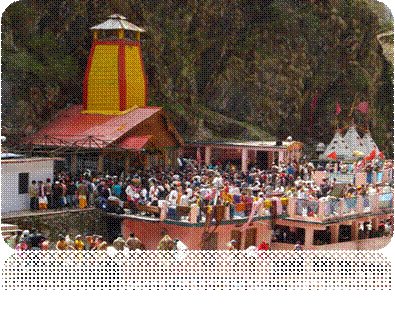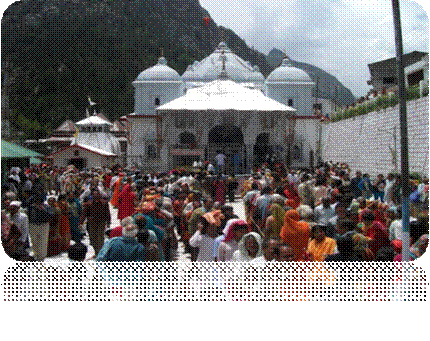The Chota Char Dham - 'the small circuit of four abodes, is an important Hindu pilgrimage circuit located in the Garhwal region of the state of Uttarakhand.The circuit consists of four sites—Yamunotri, Gangotri, Kedarnath, and Badrinath. Each aboden has its own significance and importance in Hindu mythology.
Akha-Trij or Akha-Teej (Julian and Gregorian Calendars, May) marks the beginning of the Char Dham Yatra. The 'Yatra' typically closes 2 days after Diwali, on the day of Bhai-Bij (or Bhai Dooj).
The Chota Char Dham included representatives from all three major Hindu sectarian traditions, with two Shakti (goddess) sites, (Yamunotri and Gangotri), one Shaiva site (Kedarnath), and one Vaishnava site (Badrinath).
1. Badrinath
2. Kedarnath - Kēdārnāth Mandir (Kedarnath Temple) is a Hindu temple (shrine) dedicated to Lord Shiva. This temple is the highest among the 12 Jyotirlingas. The temple is at a height of 3,583 m (11,755 ft), 223 km from Rishikesh, on the shores of Mandakini river, a tributary of Ganga, is a stone edifice of unknown date. The name "Kedarnath" means "the lord of the field": it derives from the Sanskrit words kedara ("field") and natha ("lord").
According to a theological account, the god Shiva agreed to dwell here at the request of Nara-Narayana. After the Kurukshetra War, the Pandava brothers, came here to meet Shiva on the advice of the sage Vyasa, because they wanted to seek forgiveness for killing their kin during the war. However, Shiva did not want to forgive them: so, he turned into a bull and hid among the cattle on the hill. When the Pandavas managed to track him, he tried to disappear by sinking himself head-first into the ground. One of the brothers, Bhima, grabbed his tail, forcing him to appear before them and forgive them. The Pandava brothers then built the first temple at Kedarnath. The portions of Shiva's body later appeared at four other locations; and collectively, these five places came to be known as the five Kedaras ("Panch Kedar"); the head of the bull appeared at the location of Rudranath.
3. Gangotri - Gangotri is a town and a Nagar Panchayat (municipality) in Uttarkashi district It is a Hindu pilgrim town on the banks of the river Bhagirathi and origin of River Ganges. It is on the Greater Himalayan Range, at a height of 3,100 metres (10,200 ft). According to popular Hindu legend, it was here that Goddess Ganga descended when Lord Shiva released the mighty river from the locks of his hair. The origin of the holy river is at Gaumukh, set in the Gangotri Glacier, and is a 19 km trek from Gangotri. The temple is closed from Diwali day every year and is reopened in May. During this time, the idol of the goddess is kept at Mukhba village, near Harsil. Ritual duties of the temple are supervised by the Semwal family of pujaris. These pujaris hail from Mukhba village.
Places to visit near the Gangotri Temple
- Bhagirath Shila is believed to be the holy rock where King Bhagirath prayed to Lord Shiva.
- Pandava Gufa, located 1.5 km from Gangotri, is the place where the Pandavas are believed to have meditated and rested en route Kailash. Pilgrims will have to trek up to the Pandava Gufa.
4. Yamunotri - Yamunotri is the source of the Yamuna River and the seat of the Goddess Yamuna in Hinduism. It is situated at an altitude of 3,293 metres (10,804 ft) in the Garhwal Himalayas. The sacred shrine of Yamunotri, source of the river Yamuna, is the westernmost shrine in the Garhwal Himalayas, perched atop a flank of Bandar Poonch Parvat. The chief attraction at Yamunotri is the temple devoted to the Goddess Yamuna and the holy thermal springs at Janki Chatti (7 km. Away).
The temple of Yamuna, on the left bank of the Yamuna, was constructed by Maharaja Pratap Shah of Tehri Garhwal. The deity is made of black marble. Close to the temple are hot water springs gushing out from the mountain cavities. Surya Kund is the most important kund. Near the Surya Kund there is a shila called Divya Shila, which is worshipped before puja is offered to the deity.
TOUR ITINERARY:
Char Dham yatra opens on the auspicious day of Akshay Tritiya of Chaitya month and remains open until Bhai Dooj. The complete yatra will take you 11 to 12 days. If time permits, there are a lot of other diversions such as Gaumukh, Tapovan, Along valley, Bhauravnath Temple, Vasuki Tal, Chopta, Auli, and Hemkund Sahib. You can choose to start your yatra from Delhi, Haridwar, Rishikesh, or Dehradun, according to your convenience. Delhi, being the capital, is connected to all major cities. It is also just a 5 hour train ride away from Haridwar.
Day 01:Haridwar / Dehradun – Barkot (180/06 -7 hrs)
Upon arrival we will pick up you and drive to Barkot, 06-7 hours' drive. Check in at camp. An overnight stay.
Barkot is an ideal destination to stay for pilgrims of ShriYamunotri, It is situated 45 Kms before Yamunotri temple, from where paranomic views of the Bandar punch Peaks can be seen.
Day 02: Barkot - Yamunotri - Barkot - (36kms drive & 6kms Trek one side)
Early morning after breakfast, drive to Jankichatti, start trek to Yamunotri 6 kms. You have an option to either walk or hire Pony or by Doli at your own cost.

After taking bath in Surya Kund (hot spring) visit Yamunotri temple "Darshan" and Pooja of pious "Yamunaji" at DivyaShila.
Return to camp an overnight stay.
Yamunotri Temple - Situated at 3290 meters above ocean level. The YamunotriDham is the first hallowed destination of the ChardhamYatra. This Dham is committed to Goddess Yamuna, who regarded be as a daughter of the Sun God, Surya Dev.
According to the mythological stories and convictions, the YamunotriDham was an isolation of a sage Asti Muni. For the duration of his life, the Asti Muni every day showered in both Ganges and Yamuna. Be that as it may, in his old age he didn't have the enough energy to reach Gangotri, yet his great deeds paid off and a flood of Ganges showed up inverse to Yamunotri for him. This fanciful story adds to the otherworldly worth of the Dham.
DivyaShila: A rock pillar, worshipped before entering the Yamunotri Temple.
Day 03: Barkot –Uttarkashi (80kms/03 hrs)
This morning after breakfast, check out from hotel and drive to Uttarkashi. On arrive check-in at the hotel. Later visit Vishwanath Temple.An overnight stay.
Day 04: Uttarkashi - Gangotri - Uttarkashi(100kms/03hrs one side)

After breakfast, we proceed to Gangotrienroute enjoy picturesque Harsil valley, Bhagirathi River and the most magnificent view of the Himalayas.Reach at temple Darshan and perform pooja. Thereafter we drive back to hotel. Night stay.
Gangotri - As per The Hindu mythology, Goddess Ganga - the daughter of Lord Brahma, showed herself as a waterway to acquit the transgressions of King Bhagirathi’s forerunners, taking after his extreme retribution of a few centuries, and Lord Shiva got her into his tangled locks to minimize the gigantic effect of her fall. She came to be called Bhagirathi at her incredible source. Along the right back of Bhagirathi stands the sanctum of Gangotri devoted to the Goddess. Roosted at a stature of 3042 meters (10,000 ft), it was developed in the mid 18th century by a Gorkha Commander, Amar Singh Thapa.
Day 05: Uttarkashi - Guptkashi (220kms/09hrs)
After breakfast, check out from hotel and drive to Guptkashi reach and check. An overnight stay.
Day 06: Kedarnath Ji - By Helicopter (Same Day) / by walk will take 01 more day
Early morning at 6:30 report to helipad. After performing pooja and Darshan, fly down. Reach and later you will be transfer to hotel. Night stay.

Kedarnath Temple The 1000 years old temple with a carved exterior is located in a courtyard protected by Nandi bull. This spot has great significance in the legendary Mahabharata epic. Inside the main sanctum is one of the 12 naturally formed 'Jyotirlingas' of India. The temple has carved shapes of the Pandavas, and Lord Shiva.
Day 07: Guptkashi - Badrinath (250kms/08-9hrs)
After breakfast, check out from hotel and drive to Badrinath. On arrive check – in at hotel.
Evening: Visit at Badrinath temple for Aarti ceremony.

Badrinath temple - It's so great to take in the way that this sacrosanct destination which is being dedicated to Lord Vishnu has been committed to humankind. The area where Lord Vishnu pondered under a Badri tree for thousand unremitting years and taught us a definitive method for welfare of humankind is exceptional on the planet. Today, this temple is considered as one of the holiest Hindu temples and is additionally one of the 108 DivyaDesams, sacred holy places for Vaishnavites.
Day 08: Badrinath – Rudraprayag (160 Kms / 06 Hrs)
After bath in the Taptkund visit &Darshan of Badrivishal.Brahamakamal is significant for PinddanShraddh of ancestors (Pitrus). There are other interesting sightseeing spot like Mana, VyasGufa, Maatamoorti, Bhimkund and the "Mukh" of the Saraswati River. Just within the three kms of Badrinathjee
Tapt-Kund
Just beneath the Shree BadrinathJi temple lies the TaptKund hot sulfur spring that has a high therapeutic worth. It is a freshwater pool with the washing region of 16.1/2 feet by 14.1/4 feet. Despite the fact that the typical temperature of the spring is 55°c, the temperature of water continues expanding continuously amid the day. A dunk in TaptKund is viewed as a decent restorative cure for skin illnesses.
NaradKund
NaradKund is arranged close TaptKund. It is accepted that the Badrinath icon was acquired from this kund. NaradKund boiling hot water spring is situated under the GarurShila and holds a therapeutic worth. Fans take a plunge in this kund before entering the Badrinath sanctuary for Darshan of Lord Badrinath.
Vyas& Ganesh-Gufa
Vyas& Ganesh-Gufa cavern is situated in the Mana Village alongside numerous different caverns. It is accepted that in this cavern VedVyas directed his acclaimed epic of Mahabharata to Ganesh and accordingly it has been named VyasGufa. There is an icon of VedVyas indicated composition the granth (epic book) inside this hole.
Beginning Source of Saraswati River - Manibhadrapur which is known as Mana village, the beginning source of river Saraswati. Bhimpul (bridge) according to myth it is build by Bhima during period of the Mahabharata.
Later drive to Rudraprayag. On arrive check –in at hotel and night stay.
Day 09: Rudraprayag– Dehradun/Haridwar (165 Kms /06 hrs)
After breakfast, drive to Haridwar or Dehradun to board your train /flight.
|